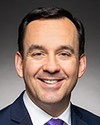Thank you.
Mr. Chair and distinguished members of the committee, thank you for inviting me to join you today to support your study on access to capital, and to tell you about the support provided by the Business Development Bank of Canada, or BDC, to aboriginal entrepreneurs.
As the BDC's national director of aboriginal banking, I manage a dedicated and passionate team that serves one of the most complex, dynamic and fastest growing markets in the country.
For those who may be less familiar with BDC, I will first provide you with some general information on its activities in support of Canadian entrepreneurs. I will then focus on our aboriginal banking unit, or ABU.
Let me begin by reminding you that BDC is the only bank in Canada dedicated exclusively to meeting the needs of entrepreneurs, with a focus on small and medium-sized enterprises. As a complementary lender, we have a greater appetite for risk than other financial institutions and we price accordingly. However, we're not the lender of last resort. Indeed, as per Treasury Board guidelines BDC must be financially sustainable. BDC does not receive government appropriations to run its daily operations. In fact, the bank has paid dividends to the Government of Canada since 1997.
We are proud to help over 30,000 Canadian SMEs that employ 674,000 Canadians and generate $192 billion in revenue annually.
Approximately 15% of our clients, or 5,000, are exporters. Our services include financing and growth and transition capital, formerly known as subordinate financing. We also offer affordable consulting services and are the largest institutional venture capital investor in Canada. Of our 30,000 clients, approximately 1.25%, or 378 clients, are aboriginal, representing $184 million in assets.
I would like to take a few moments to tell you about our team. The ABU stretches across Canada and is made up of nine dynamic individuals with over 55 cumulative years of service. Our team is committed to giving back. Members participate in 13 volunteer positions in their communities. While located in six offices across the country, we partner with aboriginal financial institutions and more than 100 BDC business centres across Canada.
The goal of BDC's aboriginal banking is to accelerate the success of aboriginal entrepreneurs by providing them with the tailored support that they need. In addition to flexible financing solutions and affordable advisory services, ABU has developed growth capital for aboriginal business, the aboriginal business development fund, and the E-Spirit national aboriginal youth business plan competition .
Not only does the ABU deliver unique services; it delivers them in a way that respects aboriginal culture and understands the unique challenges aboriginal businesses face. In fact, I myself am Métis, and several of the members of our growing team are aboriginal.
Aboriginal entrepreneurs rely mostly on personal savings to start up their businesses and even to finance ongoing operations. Well aware of this reality, BDC seeks to increase access to capital for aboriginal entrepreneurs, with commercially viable businesses located on or off reserve through its flexible financing solutions.
With growth capital for aboriginal business, aboriginal entrepreneurs on or off reserve can apply for up to $25,000 for their start-up business or up to $100,000 for their existing business. This is in addition to being able to access other BDC loans to top up their financial requirements. There are no application or annual fees. The debt-to-equity ratio of the business we support can be up to 4:1 debt equity, as distinct from our regular 3:1 debt equity. We refund a portion of the interest paid on the loan to the community under a special provision.
As you have heard from some of the other witnesses who have appeared in the context of this study, aboriginal entrepreneurs on reserve cannot leverage their lands and assets as collateral, as per section 89 of the Indian Act. Given this challenge, BDC provides financing on reserve primarily through loans made to corporations.
This is done to simplify the enforcement process, because we cannot seize or sell assets that belong to band members. When real estate is involved, we rely on mortgage of lease to secure our loans and we obtain a band council resolution to ensure that we have access to the band lands in the event of default.
When financing first nations projects, we work closely with other lenders, such as chartered banks, credit unions, and aboriginal financial institutions, in order to extend capital to aboriginal entrepreneurs. We satisfy our mandate as a complementary lender by taking more risk on projects that we finance and by partnering with other lenders when there is a funding shortfall on their projects. By doing so, we provide funding when it might otherwise not be available and we reduce other lenders' exposure to risk. By working with AFIs, we help them touch more entrepreneurs and extend more capital.
Our aboriginal business development fund provides microcredit lending for aboriginal entrepreneurs. These microloans of $2,000 to $20,000 are made available through grassroots aboriginal organizations across Canada, such as the Nuu-chah-nulth Economic Development Corporation in British Columbia. These loans are coupled with management skills training and ongoing mentorship.
This fund was created as a result of aboriginal entrepreneurs reporting the need for business management mentoring. This initiative increases access to capital for aboriginal entrepreneurs who would not normally qualify for a loan. In addition, the training and mentorship elements greatly benefit the community and create entrepreneurial capacity within it. The ABDF serves as a business model for other communities as well.
Our ABU also seeks to create awareness in the marketplace, especially amongst aboriginal youth. As you have heard from other witnesses, building business skills and awareness of self-employment opportunities is key to the economic success of first nation communities.
In order to reach aboriginal youth, we have our E-Spirit business plan competition. It is Internet-based, allowing us to reach youth in remote areas, and includes online modules, mentoring, and business plan preparation. The program incorporates both mentorship and elder components. Schools can also receive a computer to access online resources.
E-Spirit teams must submit a complete business plan and a video promoting their business idea. The winners take away cash prizes in the amounts of $4,000 for gold, $2,000 for silver, and $1,000 for bronze. In addition, special recognition awards are given for the best in various categories. E-Spirit helps aboriginal youth develop business and management skills and increases overall entrepreneurial awareness. To date, we have reached more than 6,500 grade 10 to grade 12 students through this program.
To conclude, I will again say that we are committed to making the most of the potential of aboriginal SMEs. We are working to ensure that they have all the tools and support they need to succeed. With the aboriginal banking team, our priorities are to improve the client experience and expand our reach and visibility. We are building our team and further developing our skills and our knowledge, which are unique in this field, to better serve aboriginal entrepreneurs and support their growth.
Thank you for your attention. We would be pleased to answer your questions.









